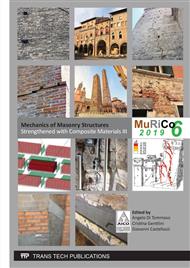[1]
T.T. Soong, Random differential equations in science and engineering, Academic Press, (1973).
Google Scholar
[2]
J. Li, J. Chen, Probability density evolution method for dynamic response analysis of structures, with uncertain parameters, Computational Mechanics, 34, (2004), 400-409.
DOI: 10.1007/s00466-004-0583-8
Google Scholar
[3]
J. Li, J. Chen, The principle of preservation of probability and the generalized density evolution equation, Structural Safety, 30, (2008), 65-77.
DOI: 10.1016/j.strusafe.2006.08.001
Google Scholar
[4]
J. Li, J. Chen, Stochastic Dynamics of structures, John Wiley & Sons, (2009).
Google Scholar
[5]
M. Lucchesi, B. Pintucchi, N. Zani Modelling masonry structures through the MADY code 2nd International Conference. on recent avances in nonlinear models – design and rehabilitation of structures. CORAS 2017, 1-10 (2017).
Google Scholar
[6]
M. Lucchesi, B. Pintucchi, N. Zani, Masonry-like materials with bounded shear stresses European J. Mech-A Solids 72, (2018), 329-340.
DOI: 10.1016/j.euromechsol.2018.05.001
Google Scholar
[7]
M. Lucchesi, B. Pintucchi, N. Zani, Bounded shear stress in masonry-like bodies Meccanica 53, (2018),1777-1791.
DOI: 10.1007/s11012-017-0719-9
Google Scholar
[8]
L. Hormander, The analysis of linear partial differential operators I, Springer-Verlag (1990).
Google Scholar
[9]
Lucchesi, M., Pintucchi, B., A numerical model for non-linear dynamics analysis of masonry slender structures, European Journal of Mechanics A/Solids, 26, (2007), 88-105.
DOI: 10.1016/j.euromechsol.2006.02.005
Google Scholar
[10]
M. Lucchesi, B. Pintucchi, M. Šilhavý, N. Zani, On the dynamics of viscous masonry beams. Continuum Mechanics and Thermodynamic, 27, (2015), 349-365.
DOI: 10.1007/s00161-014-0352-y
Google Scholar
[11]
B. Pintucchi, N. Zani, A simple model for performing nonlinear static and dynamic analyses of unreinforced and FRP-strengthened masonry arches. European Journal of Mechanics /A Solids, 59, (2016) 210-231.
DOI: 10.1016/j.euromechsol.2016.03.013
Google Scholar
[12]
M. Lucchesi, B. Pintucchi, N. Zani, Dynamic analysis of FRP-reinforced masonry arches via a no-tension model with damage, Key Engineering Materials, (2015).
DOI: 10.4028/www.scientific.net/kem.624.619
Google Scholar
[13]
L. Salvatori, A.M. Marra, G. Bartoli, P. Spinelli, Probabilistic seismic performance of masonry towers: General procedure and a simplified implementation, Engineering Structures 94, 82–95, (2015).
DOI: 10.1016/j.engstruct.2015.02.017
Google Scholar


